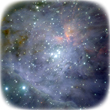
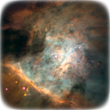
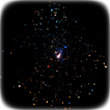
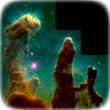
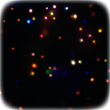
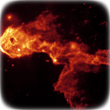
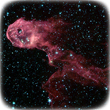
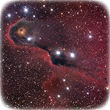
























Stars are believed to have been forming in the Orion Nebula, from collapsing clouds of dust and gas, over only the past few million years - which is not very long ago at all, on astronomical timescales. By way of comparison, our Sun and solar system probably formed about 5 billion years ago, so they're very much older. Really prominent in the central region of the Orion Nebula, are four recently-formed, very hefty massive stars—each is about 15 to 30 times the mass of the Sun. These stars, the so-called Trapezium stars, have been literally blasting out ultraviolet radiation into the rest of the nebula. The blast of radiation has pushed away the gas and dust that used to surround them and created a bowl-like cavity. And it’s because of this cavity that the visible light emitted by the stars can escape the nebula—and that’s what makes it very bright at the center. By contrast, other massive stars are still in the process of formation in the Orion Nebula, perhaps in vast pillars of dense gas and dust. These forming stars remain undetectable in visible light, even to powerful telescopes such as Hubble. Finally, low-mass stars are also forming in the Orion Nebula. It's a whole zoo of star formation! Some still have disks of material encircling them that could eventually form planets and new solar systems. It’s these disks that are now being studied intensively to answer the question about how planetary solar systems form.